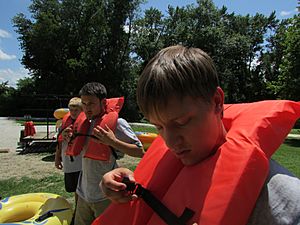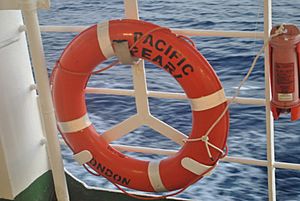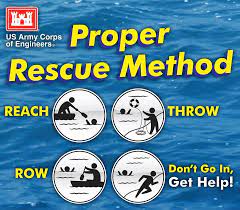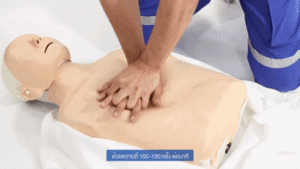Drowning facts for kids
Drowning happens when someone's nose and mouth are underwater for too long, and they can't breathe. Most of the time, when someone drowns, the people nearby don't realize what's happening or can't help.
Things that can increase the risk of drowning include health conditions like epilepsy, not knowing how to swim well, or, for kids, not having an adult watching them. Common places where drowning happens are rivers, lakes, bathtubs, and swimming pools.
Even though "drowning" often sounds like it means death, it can actually have different outcomes. Sometimes, people drown and die. Other times, they might have long-term health problems, or they might recover completely with no lasting issues. When someone recovers, it's sometimes called "near-drowning."
To prevent drowning, it's important to teach both kids and adults how to swim. It's also good to learn about unsafe water conditions. Always swim with a friend, and use life jackets when you're on boats or swimming in tricky waters. Making sure swimming pools are fenced off and having adults watch children closely are also key prevention steps.
If someone isn't breathing after being rescued from water, the first thing to do is open their airway and give them five breaths of mouth-to-mouth resuscitation. If their heart has stopped, Cardiopulmonary resuscitation (CPR) is recommended, especially if they were underwater for less than an hour.
After being rescued, people who have drowned might have trouble breathing, vomit, feel confused, or be unconscious. Sometimes, these problems don't show up until several hours later. Even a little bit of water in the lungs can cause irritation. This can lead to fluid building up in the lungs, making it hard to breathe. This serious reaction can happen up to 72 hours after the incident and can be very dangerous.
In many countries, drowning is one of the main causes of death for children under 14 years old. About 90% of drownings happen in fresh water like rivers, lakes, and pools. The other 10% happen in seawater. Drowning in other liquids is rare and usually happens in industrial accidents.
Contents
- Preventing Drowning Accidents
- Watching Swimmers Closely
- Learning to Swim is Key
- More Water Safety Education
- Fencing Around Pools
- Safe Pool Drains
- Being Careful with Certain Conditions
- Using Life Jackets
- Knowing Water Depth
- Avoiding Dangerous Waters
- Boating Safely
- Using the "Buddy System"
- Rescue Robots and Drones
- Following the Rules
- How Long Can Someone Stay Underwater?
- Helping Someone Who is Drowning
- Images for kids
- See also
Preventing Drowning Accidents
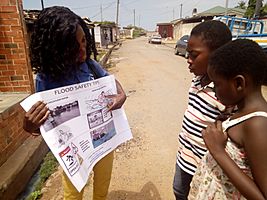
Experts believe that more than 85% of drownings could be stopped. This can be done through good supervision, learning water skills, using technology, and teaching the public.
Watching Swimmers Closely
Watching people swim is super important because drowning can happen silently. A person who is drowning might not be able to call for help, often because they become unconscious.
- Supervising Children: It's very important to watch children. Most drownings globally happen to kids under five. Young children should always be watched, even if they know how to swim. The danger is much higher when they are alone. A baby can drown in a bathtub, a toilet, or even a small bucket with just a little water.
- Time is Critical: It only takes about 2 minutes for an adult to lose consciousness underwater. For a small child, it can take only 30 seconds to 2 minutes to die.
- Safe Swimming Spots: Choosing places with lifeguards is much safer. Many pools have lifeguards or pool safety camera systems. Some even use computers to help detect if someone is drowning.
- Bystanders Help: People nearby are also important. They can spot someone in trouble and tell lifeguards, or call for help if there are no lifeguards.
Learning to Swim is Key
Knowing how to swim is one of the best ways to protect yourself from drowning.
- When to Learn: It's a good idea for children to learn to swim in a safe place with supervision when they are between 1 and 4 years old. Adults can also learn to swim using similar methods.
- Stay Safe: Even if you know how to swim, you can still drown if the water conditions are bad or other things happen. So, always choose safe swimming spots that are watched by others.
More Water Safety Education
The World Health Organization (WHO) suggests teaching everyone basic first aid for drowning victims, like CPR. They also recommend teaching people how to act safely when they are in or near water. People who can't swim should learn to stay away from deep water.
Fencing Around Pools
Every private and public swimming pool should have a fence all around it. This stops people from getting into the water without supervision. For example, in France, a law in 2003 made it mandatory to fence pools.
Safe Pool Drains
Swimming pools have drains to keep the water clean. Drains without covers can be dangerous. They can trap hair or other body parts, making it impossible for a swimmer to move and leading to drowning.
- Drain Safety: Drains should not pull too strongly. It's better for a pool to have many small drain holes instead of one big one. Pools should be checked regularly to make sure their drain systems are working safely.
Being Careful with Certain Conditions
Some health conditions mean you need to be extra careful near water.
- Epilepsy and Seizures: For example, if someone has epilepsy or other seizure disorders, they have a higher risk of drowning during a seizure. This makes swimming, diving, and bathing more dangerous. It's recommended that people with these conditions take showers instead of baths and learn about the dangers of drowning.
Using Life Jackets
Children who can't swim and anyone else at risk of drowning should wear a properly fastened and well-fitting life jacket when they are near or in the water.
- Other Floatation Devices: Other floating items like inflatable inner tubes or water wings can be helpful, but they are usually considered toys.
- Professional Gear: Professional floating tools, like the round lifebuoy (also called a hoop-buoy or life preserver), are designed to be thrown to someone in trouble. Lifeguards also use special floating devices for rescues.
Knowing Water Depth
Diving into shallow pools can cause serious injuries.
- Spinal Injuries: Up to 21% of diving accidents in shallow water can lead to spinal injuries, which sometimes cause death. Between 1.2% and 22% of all spinal injuries come from diving accidents. If the person doesn't die, the injury could cause permanent paralysis. Always check the depth before diving!
Avoiding Dangerous Waters
It's best to avoid swimming in water that is too rough, has big waves, dangerous animals, or is too cold.
- Dangerous Currents: Also, stay away from strong, turbulent currents that can pull people or objects. If you get caught in one, try to swim out of it by moving diagonally towards the shore.
Boating Safely
Many people who drown are involved in boating accidents.
- Safety Gear: Safe boating means knowing what the sea conditions are like and having the right safety equipment on board. This includes life jackets (as mentioned above) and professional round lifebuoys.
Using the "Buddy System"
Never swim alone! Always swim with another person who can help if something goes wrong. This is called the "buddy system."
Rescue Robots and Drones
Today, there are some cool remote-controlled devices that can help with water rescues.
- Floating Robots: Floating rescue robots can move across the water, allowing a person in trouble to hold on and be pulled to safety.
- Flying Drones: Flying drones are very fast. They can drop life jackets from the air and help find someone who is lost in the water.
Following the Rules
Many people who drown did not follow the safety rules of the area. It's important to pay attention to signs that tell you if swimming is allowed or if a lifeguard is on duty. Always listen to lifeguards or coastguards.
How Long Can Someone Stay Underwater?
The amount of time a person can safely stay underwater depends on many things. These include how much energy they are using, how many breaths they took before going under, their physical fitness, and their age. On average, a person can last between one and three minutes before losing consciousness. They can last about ten minutes before dying.
Helping Someone Who is Drowning
Rescue Steps
When someone is drowning or missing in the water, a quick rescue is needed to get them out as fast as possible. Drowning isn't always noisy with splashing and cries; it can be very silent.
- Stay Safe Yourself: Rescuers should avoid putting themselves in danger. If possible, help from a safe spot like a boat, a pier, or the land.
- Throw, Don't Go: The fastest way to help is to throw something that floats, like a lifebuoy. Be careful not to hit the person directly, as even light lifebuoys can hurt them.
- Reach Out: Another way is to pull the person out by holding out an object they can grab, like a rope, an oar, a pole, or even your arm or hand. If you do this, make sure you have a firm footing and are secured so you don't get pulled in.
- Modern Help: Modern flying drones can also drop life jackets to people in trouble.
- Call for Help: People nearby should immediately call for help. If there's a lifeguard, call them. If not, call emergency services (like paramedics) as soon as possible.
- Bystander Risks: Less than 6% of people rescued by lifeguards need medical help, and only 0.5% need CPR. These numbers are worse when rescues are made by people who aren't trained lifeguards.
- Robots Can Help: If lifeguards or paramedics can't be called, people nearby might have to try a rescue. But remember, human rescue can be risky for the rescuer, who could also drown. This can happen because of water conditions, the drowning person's panic, or physical exhaustion. Small floating robots can reach the person, which is safer for rescuers.
Making Contact with the Victim
Once you reach the person, how you make contact is important. A panicking person might cling to you, trying to stay above water, which could pull you under.
- Use a Floating Object: To avoid this, it's best to approach with something that floats or by extending your hand, so they have something to grab.
- Approach from Behind: You can also approach from behind, grab one of their arms, and press it against their back to limit their movements. Talking to them is also important.
- If They Cling: If the person clings to you and you can't control the situation, you can try diving underwater. Drowning people tend to push upwards, so this might help them let go.
- Underwater Rescue: If the person has already sunk, be careful, as they might still be conscious and grab you underwater. To bring them to the surface, grab one or both of their arms and swim upwards. This might encourage them to move in the same direction, especially if they are unconscious. If they are in deep water, dive down, grab them from behind, and swim straight up to the surface.
Getting Them Out of the Water
Finally, the person needs to be taken out of the water. This is done by towing them.
- Towing Method: Place the person face-up in the water. Put one hand under their armpit and then grab their jaw with that hand. Swim backward to tow them. Make sure their mouth and nose stay above the water.
- Cooperative Person: If the person is cooperative, you can tow them by putting your hands under their armpits. Other towing styles are possible, but always keep their mouth and nose above the water.
- Unconscious Person: Unconscious people can be pulled more easily, perhaps by a wrist or their shirt, while they are face-up.
- Spinal Injuries: If you suspect a spinal injury, special care and a backboard might be needed.
- In-Water Resuscitation: For unconscious people, starting resuscitation in the water can greatly increase their chances of survival. However, this needs both medical and swimming skills. If the person doesn't respond after a few breaths, assume their heart has stopped, and getting them out of the water becomes the top priority.
First Aid After Rescue
Once the person is out of the water, check if they are responsive and breathing.
- Recovery Position: If they are unconscious but breathing, place them in the recovery position (on their side).
- Rescue Breaths: If they are not breathing, rescue breaths are needed. Drowning often causes gasping or stops breathing while the heart is still beating, so just giving breaths might be enough.
- ABC Sequence: Follow the ABC (Airway, Breathing, Circulation) sequence. This means focusing on breathing first, because the main problem is a lack of oxygen.
- Starting Breaths: For anyone older than a baby, start with 5 normal rescue breaths. It might be hard to get air in at first because of water in the airways. After the first 5 breaths, continue with a pattern of 2 rescue breaths followed by 30 chest compressions. Repeat this until the person shows signs of life, you can't continue, or medical help arrives.
- For Babies: For very small babies, the process is a bit different. For each set of rescue breaths (the first 5 and then the sets of 2), cover both the baby's mouth and nose with your mouth (because their face is small). For the 30 chest compressions, use only two fingers to press on the lower part of their chest bone, as their bodies are more fragile.
- Avoid Water Removal Methods: Do not try to remove water from the airway using methods like abdominal thrusts or the Heimlich maneuver. There isn't a solid blockage, and these methods delay breathing and increase the risk of vomiting. Vomiting can make the situation worse.
- Treating Cold: If the person is very cold (hypothermia), they might need treatment to warm up. However, if they are unconscious, their temperature should not be raised above 34 degrees Celsius.
- Diving Reflex: Sometimes, people who were in very cold water and seemed to have drowned can recover after a long time underwater. This is due to something called the "diving reflex." So, if you rescue a child from very cold water, always try to resuscitate them, even after a long immersion.
Images for kids
See also
 In Spanish: Ahogamiento para niños
In Spanish: Ahogamiento para niños




